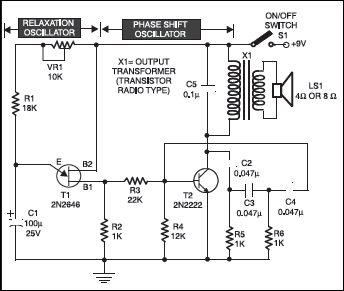 The timer circuit described here provides a pleasant musical tone in your darkroom at 1-second intervals.The circuit takes up very little space and can be easily converted into a metronome.
The timer circuit described here provides a pleasant musical tone in your darkroom at 1-second intervals.The circuit takes up very little space and can be easily converted into a metronome.

Unijunction transistor (UJT) T1 functioning as a relaxation oscillator triggers the phase-shift audio oscillator circuit built around transistor T2, turning it on and off. As capacitor C1 is charged through preset VR1 and resistor R1, the emitter voltage of UJT rises toward the supply voltage.
When the emitter voltage becomes sufficiently positive, the emitter becomes forward biased and discharges capacitor C1 through the emitter-base 1 (B1) junction and resistor R2. The voltage drop across R2 forward biases transistor T2 and turns it on. As capacitor C1 becomes discharged, the current through resistor R2 drops and transistor T2 is cut off.
A tone signal is generated by transistor T2 and R-C coupled phase-shift oscillator. Part of the signal taken from the collector of transistor T2 is coupled to a small speaker through a transistor-radio type output transformer.
The 22-kilo-ohm value of resistor R3 represents a compromise between tone duration and intensity. You can use resistors having a value anywhere between 10 kilo-ohms and 25 kilo-ohms for different durations and intensities of the output signals.
Since the unijunction transistor is functioning as the oscillator trigger, changing the values of one or more components in the UJT circuit will change the rate of the tone burst. The tone frequency can be varied by changing the value of any or more of capacitors C2 through C4 and resistors R5 and R6 in the phase-shift network.
The primary winding of transformer X1 can be tuned for a slight increase in the output, using capacitor values between 0.05 and 0.25 μF for C5 by trial-and-error method. Tone pulses should begin about ten seconds after the unit is turned on. After a minute or so, adjust preset VR1 for 1-second beats by comparing the timing of the beats with the seconds needle on your wristwatch.






